![]()
Aroids and other genera in the Collection
Take the Tour Now?
Orchids
The
Exotic Rainforest
Plants in
the Exotic Rainforest Collection
The images on this website are copyright protected. Please contact us before any reuse.
Detailed information on Growing Anthurium
Species Click this Link
Within our collection we have many species of Anthurium. If you are seeking other photos, click this link:
New: Understanding, pronouncing and using Botanical terminology, a Glossary
Anthurium warocqueanum J. Moore Florist & Pomol
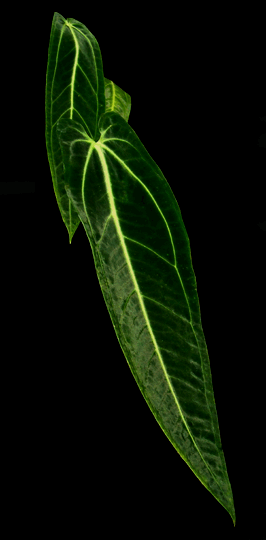
The beauty of some rare plants simply defy description. Anthurium warocqueanum is near the top of the list of those that defy. From the wet forests of Columbia in northern South America is a spectacular epiphytic tree dweller (an epiphyte (ep-a-FIT) is simply a plant that grows upon another plant) known to collectors as the Queen Anthurium: Anthurium warocqueanum. Although the center of the second Latin name appears to spell "queen", it just depends on which book or internet article you read! But collectors settled long ago on the common name they prefer: Queen.
A member of Anthurium section Cardiolonchium which includes Anthurium species with a velutinous (velvet) appearing leaf blades, Anthurium warocqueanum is said by some to be difficult to grow. We have seen it do nothing but grow!
If you
search you can now find small specimens which were created through the
use of tissue culture (cloning) and purchase them relatively cheaply.
However, a cloned plant almost never has the natural beauty of a
seed grown
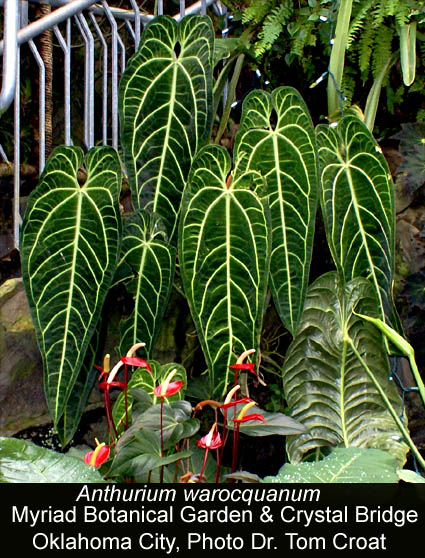 specimen. Our original specimens were small 5cm (2
inch leaves) when they arrived but have since acquired leaves of
approximately 30 to 45cm (12 to 18 inches), one even larger.
One plant which arrived from Hawaii now has leaves
closer to 60cm (2 feet). The
leaves of Anthurium warocqueanum will eventually grow to
almost 2 meters (six feet)! The larger the leaf becomes the more pronounced the silver white
veins. Lots of water appears to be the clue to causing this
species to grow! It is afterall, a rain forest species!
This plant is highly variable and may take on many
shapes, forms and patterns. You can see just some of those
forms near the bottom of this page. Within the world of aroid botany
there is no such thing as a single leaf shape, color or size!
specimen. Our original specimens were small 5cm (2
inch leaves) when they arrived but have since acquired leaves of
approximately 30 to 45cm (12 to 18 inches), one even larger.
One plant which arrived from Hawaii now has leaves
closer to 60cm (2 feet). The
leaves of Anthurium warocqueanum will eventually grow to
almost 2 meters (six feet)! The larger the leaf becomes the more pronounced the silver white
veins. Lots of water appears to be the clue to causing this
species to grow! It is afterall, a rain forest species!
This plant is highly variable and may take on many
shapes, forms and patterns. You can see just some of those
forms near the bottom of this page. Within the world of aroid botany
there is no such thing as a single leaf shape, color or size!
This species often has dark green leaves which are thick with a velvety appearance but they may also be substantially lighter in shade. Leaves that are both thick and tough are known botanically as coriacious (leathery). But they are still susceptible to the ravages of garden bugs and wind. Anthurium warocqueanum is rarely if ever found growing in soil in nature.
Anthurium warocqueanum produces an inflorescence including a spathe (sometimes incorrectly called a "flower") which is somewhat twisted. That inflorescence is not truly the "flower" of the plant, but instead, simply a modified leaf. The true flowers are very small and grow along the spadix which is the center "stalk" of the inflorescence.
This link explains the purpose of the spathe and spadix and how the aroid naturally reproduces.
The word "epiphyte" comes from two Greek words: "epi" which means upon, and "phyton" which means plant. Thus an epiphyte is a plant that grows upon another plant. The spathe is pale yellow-green and lanceolate (spear shaped). The spadix is where seeds may form if pollinated and can grow to approximately 41cm (16 inches) and produces light red berries which will contain the seeds. Birds eat the berries and deposit the seeds on a tree branch in their own droppings which again begins the cycle of a plant growing upon a plant.
According to information provided by Dr. Tom Croat of the Missouri Botanical Garden where at least one full grown specimen is hidden away in the research greenhouse, Anthurium warocqueanum is endemic (exclusively found in nature)in the Pacific lowlands and the intermountain valleys of Central and Western Colombia. It occurs in moist to wet forests from low elevations to approximately 1,430 meters (4,500 feet). In some regions it is moderately rare and is often found on tree trunks just 2.5 meters (9 feet) above the ground. The plant appreciates filtered sunlight and ample water since it captures all its moisture directly from falling rain and the humid climate. Members of Anthurium section Cardiolonchium do not flourish under nor enjoy bright light!
The species
is
variable and you may find it available in a several colorations,
shapes and patterns.
Not every plant has
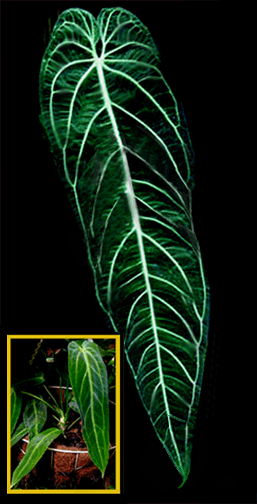 the same appearance! Although sometimes offered as "new species", that is dubious at
best since those variations in color and pattern are very normal. As with most aroid species, these are simply natural
variations.
the same appearance! Although sometimes offered as "new species", that is dubious at
best since those variations in color and pattern are very normal. As with most aroid species, these are simply natural
variations.
A note from Hawaiian collector Windy Aubrey explained just how variable the plant can be, "I have several forms of Warocs. It's one of 'those' plants I liked, so I would pick them up when ever I saw them over the years. I must have at least 20 examples of this species." She continued, "I think I have a least three different forms (maybe four, if you count the one form with the open sinus). I have one form that is glaucous, one form that is very, very dark and the normal form. I also have one that was collected in Colombia by an old timer here on Oahu. That one is totally different, so it might even be a different species or natural hybrid since it was field collected. It is similar, but has a blade that is wider and shorter. Windy grows numerous forms of the species, all appear different, but are one single Anthurium species. A sample of her collection is seen below.
What began this discussion is a recent offer on eBay for a "black A. warocqueanum". At first, I was very doubtful of the claim about a "new species" and after some discussion with other growers I elected to the plant simply out of curiosity. Once it arrived I could see no difference in the Anthurium warocqueanum I was growing and the new plant other than the color was slightly darker. There was a slight difference in the vein structure but that easily falls within natural variation within the species.
We started our plants in a
mixture of good potting soil, lots of peat, Perlite™, orchid potting
mix containing bark, charcoal and gravel, and crushed volcanic rock. The orchid mix was added since the plant normally has it's roots attached to a tree. And the
peat, volcanic rock, and Perlite™
were added to hold water without becoming soggy. However, once
the plant's roots were fully established we moved all three to large
square orchid baskets with the roots packed with orchid moss to
allow growth similar to the way the plant is found in the rain
forest. In nature this species collects falling debris, such
as leaves, which hold water for the roots to gather moisture as
needed. The roots of our specimens are now attached to the
wood of the basket just as the plant would attach itself to a tree
in nature. The orchid moss holds ample
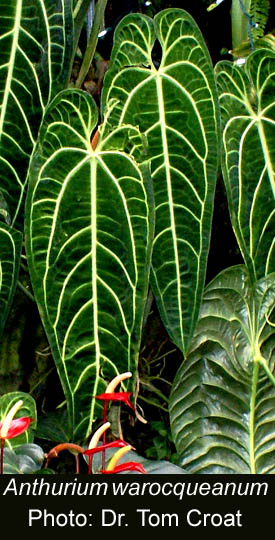 water similar to the
falling debris. The roots are beginning to hang from the
bottom of the wooden basket and in the forest
they often
extend several meters beneath a
specimen. By doing so, those roots collect as much rain fall
as possible. Within our rain forest atrium all of our
specimens are watered daily during the heat of the year twice each
day for 10 minutes at any time from an automatic overhead watering
system. During the winter months the water is reduced, but
never stopped! Rain forest plants love water!
water similar to the
falling debris. The roots are beginning to hang from the
bottom of the wooden basket and in the forest
they often
extend several meters beneath a
specimen. By doing so, those roots collect as much rain fall
as possible. Within our rain forest atrium all of our
specimens are watered daily during the heat of the year twice each
day for 10 minutes at any time from an automatic overhead watering
system. During the winter months the water is reduced, but
never stopped! Rain forest plants love water!
You will note I didn't called Anthurium warocqueanum either the queen or the king Anthurium. The word "queen is almost spelled out within the scientific name Anthurium warocqueanum and the species is commonly accepted as the Queen Anthurium. There appears to be some debate about which plant is the King or Queen as the result of a passage by author Deni Bown who wrote Aroids, Plants of the Arum Family, a principal reference on aroids. Check page 312 of her book. She names Anthurium veitchii as the "Queen". The majority of collectors accept Anthurium warocqueanum as the queen, but since the name is non-scientific, the choice appears to be up to the collector.
Still unsure how natural variation within a species may appear? Take a look at just some of the forms of Anthurium warocqueanum grown by aroid grower Windy Aubrey in Hawaii below. In nature, variation is even more wide spread! And once you examine her photos read the link given here for a better explanation of what botanists have known for years to be natural variation within a species. Every leaf does not have to look alike! Click here.
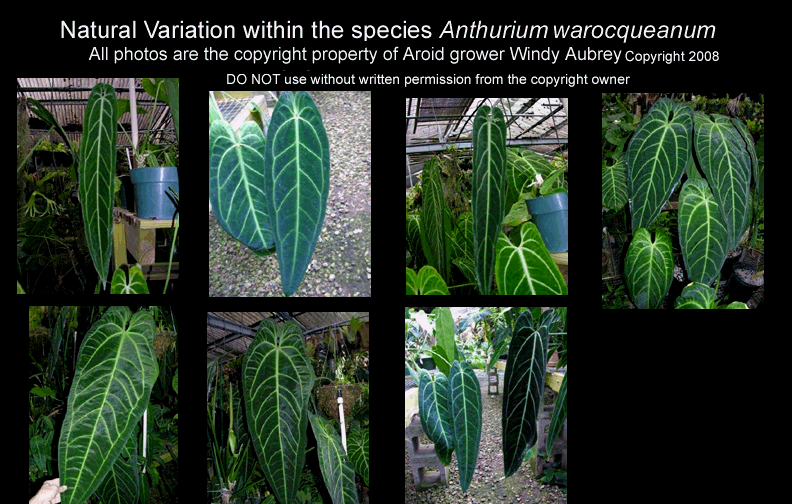
Aroid Pollination!
As
it occurs in nature and by any horticulturist
Need more information on Anthurium species? Click this link.
Join the International Aroid Society: http://www.exoticrainforest.com/Join%20IAS.html
If you are seeking information on
other rare species, click on "Aroids and other genera in the Collection" at the top
and look for the